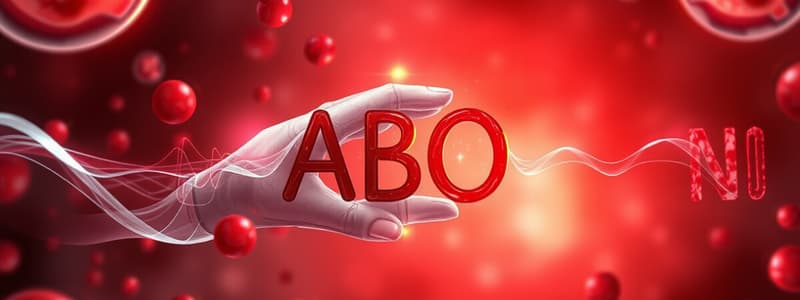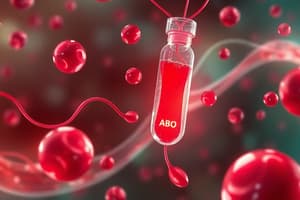Podcast
Questions and Answers
What is the primary significance of the ABO blood group system?
What is the primary significance of the ABO blood group system?
- It identifies individuals for blood donation eligibility.
- It plays a crucial role in transfusion and transplantation. (correct)
- It helps in diagnosing blood-related diseases.
- It is used mainly for determining genetic inheritance.
Why is the ABO blood group system considered the most important blood group system?
Why is the ABO blood group system considered the most important blood group system?
- It is universally applicable across all countries.
- It is the only blood group system that determines blood type.
- It has the most complex genetic variation compared to others.
- It is crucial for patient safety in medical procedures. (correct)
Which of the following statements accurately reflects the role of the ABO blood group system?
Which of the following statements accurately reflects the role of the ABO blood group system?
- It is essential for compatibility in transplantation. (correct)
- It has no impact on organ transplantation.
- It can be disregarded in emergency medical situations.
- It is primarily used for research purposes in hematology.
How does the ABO blood group system differ from other blood group systems?
How does the ABO blood group system differ from other blood group systems?
What aspect of the ABO blood group system contributes to its complexity in transfusion medicine?
What aspect of the ABO blood group system contributes to its complexity in transfusion medicine?
What is the role of the H gene in the context of A-specific immunodominant sugar?
What is the role of the H gene in the context of A-specific immunodominant sugar?
Which of the following best describes the precursor substance mentioned in the context of A-specific immunodominant sugar?
Which of the following best describes the precursor substance mentioned in the context of A-specific immunodominant sugar?
What characteristic does the A-specific immunodominant sugar possess?
What characteristic does the A-specific immunodominant sugar possess?
In the relationship between the immunodominant sugar and the H substance, what action is primarily involved?
In the relationship between the immunodominant sugar and the H substance, what action is primarily involved?
Which statement accurately reflects the specificity of the mentioned sugar?
Which statement accurately reflects the specificity of the mentioned sugar?
At what age is the expression of antigens considered fully developed in individuals?
At what age is the expression of antigens considered fully developed in individuals?
What percentage of antigenic sites do newborn RBCs carry at most?
What percentage of antigenic sites do newborn RBCs carry at most?
How is the strength of reaction of newborn RBC with reagent antisera compared to adult RBC?
How is the strength of reaction of newborn RBC with reagent antisera compared to adult RBC?
What factor may influence the phenotypic expression of ABH antigens?
What factor may influence the phenotypic expression of ABH antigens?
What is the secretory status of ABH soluble antigens?
What is the secretory status of ABH soluble antigens?
What is the consequence of transfusing incompatible blood due to naturally occurring antibodies in the ABO blood group system?
What is the consequence of transfusing incompatible blood due to naturally occurring antibodies in the ABO blood group system?
Which statement is true about the performance of serum grouping in ABO blood group system?
Which statement is true about the performance of serum grouping in ABO blood group system?
What is the peak age for the production of ABO antibodies?
What is the peak age for the production of ABO antibodies?
Why is it illogical to perform reverse grouping in newborn infants?
Why is it illogical to perform reverse grouping in newborn infants?
What characterizes the antibodies produced in the ABO blood group system?
What characterizes the antibodies produced in the ABO blood group system?
What relationship exists between the forward and reverse typing in the ABO blood group system?
What relationship exists between the forward and reverse typing in the ABO blood group system?
Which subgroup of type A blood is rarely found in the Asian population?
Which subgroup of type A blood is rarely found in the Asian population?
What typically happens to anti-A and anti-B antibody levels in elderly individuals?
What typically happens to anti-A and anti-B antibody levels in elderly individuals?
What role does the FUT2 gene play in the secretory phenotype of antigens?
What role does the FUT2 gene play in the secretory phenotype of antigens?
Which mutation in the ABO gene directly results in the inactive form of the A transferase enzyme?
Which mutation in the ABO gene directly results in the inactive form of the A transferase enzyme?
A2 RBC exhibit specific characteristics compared to A1 RBC. Which statement accurately reflects this difference?
A2 RBC exhibit specific characteristics compared to A1 RBC. Which statement accurately reflects this difference?
In the case of weak A subgroups, which characteristic is typical for these individuals?
In the case of weak A subgroups, which characteristic is typical for these individuals?
How do Bombay phenotype individuals react to anti-H sera, and what does this imply?
How do Bombay phenotype individuals react to anti-H sera, and what does this imply?
Which genetic condition results in the inability to produce H antigens, as seen in the Bombay phenotype?
Which genetic condition results in the inability to produce H antigens, as seen in the Bombay phenotype?
Which of the following tests is utilized to differentiate weak A subgroups through their reactions with specific antibodies?
Which of the following tests is utilized to differentiate weak A subgroups through their reactions with specific antibodies?
Para-Bombay phenotypes are characterized by which of the following genetic conditions?
Para-Bombay phenotypes are characterized by which of the following genetic conditions?
What allows for the distinction between A1 and A2 RBC during serological testing?
What allows for the distinction between A1 and A2 RBC during serological testing?
For ABO subgroups, which aspect is primarily responsible for differences in the transfer of immunodominant sugars to H substance?
For ABO subgroups, which aspect is primarily responsible for differences in the transfer of immunodominant sugars to H substance?
What type of antibodies are typically present in the serum of individuals with the Bombay phenotype?
What type of antibodies are typically present in the serum of individuals with the Bombay phenotype?
Weak B subgroups are typically recognized by which of the following criteria?
Weak B subgroups are typically recognized by which of the following criteria?
What is the primary consequence of not having an active FUT1 gene in individuals with Para-Bombay phenotypes?
What is the primary consequence of not having an active FUT1 gene in individuals with Para-Bombay phenotypes?
Which factor primarily differentiates the A2 antigen formation from A1 antigen formation?
Which factor primarily differentiates the A2 antigen formation from A1 antigen formation?
Flashcards are hidden until you start studying
Study Notes
Introduction to ABO Blood Group System
- ABO blood group system is crucial for blood transfusion and transplantation.
- Unique feature: individuals have antibodies against absent RBC antigens without prior exposure, leading to immediate lysis of incompatible donor RBCs.
- Incompatible transfusions can cause severe, potentially fatal transfusion reactions.
ABO Grouping Methods
- Forward Grouping (Front Type): Utilizes known antisera (anti-A, anti-B) to identify antigens on RBCs.
- Reverse Grouping (Back Type): Detects ABO antibodies in serum using known reagent RBCs (A1 and B cells).
- There is a reciprocal relationship between forward and reverse typing, serving as validation for results.
- Serum grouping is specific to the ABO blood group system.
Development of ABO Antibodies
- At Birth: ABO antibody production begins but is undetectable until 3-6 months due to low titers.
- Antibody levels peak between 5-10 years and decline in the elderly, possibly causing undetectable levels in reverse typing.
- Predominantly IgM antibodies that activate complement, react at room temperature.
- RBCs of newborns have 25-50% antigenic sites compared to adults, with full antigen expression by age 2-4.
Secretory Status
- Soluble ABH antigens found in body secretions; 80% of random U.S population are "secretors."
- Secretor status depends on inheritance of ABO genes and the secretor gene (Se or FUT2) on chromosome 19.
- FUT2 gene modifies the precursor substance to express A and B substances in secretions like saliva.
Molecular Genetics of ABO
- ABO gene located on chromosome 9 consists of 7 exons; exons 6 and 7 account for 77% of the gene.
- Mutations lead to A, B, or O specificities due to changes in enzyme functionality.
- A2 subgroup arises from specific mutations in the A2 gene affecting glycosyltransferase activity.
A Subgroups
- Majority of group A individuals are A1 or A1B; 20% are A2 or A2B.
- A2 has fewer antigen sites (240,000 to 290,000) resulting in less efficient conversion of H antigen to A antigen.
Characteristics of A2 Antigen
- Four types of H antigens characterized as unbranched or branched chains.
- A1 RBCs react with both anti-A and anti-A1, while A2 RBCs only react with anti-A and show more reactivity with anti-H lectin.
- A2 group exhibits occasional formation of anti-A1 antibodies.
Weak A and Weak B Subgroups
- Weak A subgroups are rare and identifiable through serological discrepancies.
- Characteristics: fewer A antigen sites, varying agglutination with anti-A, and variability in H antigen detectability.
- Weak B subgroups observed via reaction strength with anti-B and anti-A, B techniques.
Bombay Phenotype (Oh)
- Caused by inheritance of hh genotype, resulting in absence of ABH antigens due to lack of H antigen.
- Inherited as an autosomal recessive trait linked to mutations in FUT1 gene.
- Bombay phenotype RBCs do not react with anti-A, anti-B, or anti-H antisera, mimicking O blood type.
Antibodies in Bombay Serum
- Bombay serum contains anti-A, anti-B, anti-A,B, and anti-H antibodies capable of strong reactions at 37°C.
- Only compatible blood for transfusion comes from other Bombay phenotype individuals.
Para-Bombay Phenotypes
- Exhibit reduced or absent H antigens; genetic basis includes mutations in FUT1 and/or FUT2 genes.
- Individuals show very low levels of A or B antigens, undetectable by routine methods but identifiable using adsorption and elution techniques.
Studying That Suits You
Use AI to generate personalized quizzes and flashcards to suit your learning preferences.




